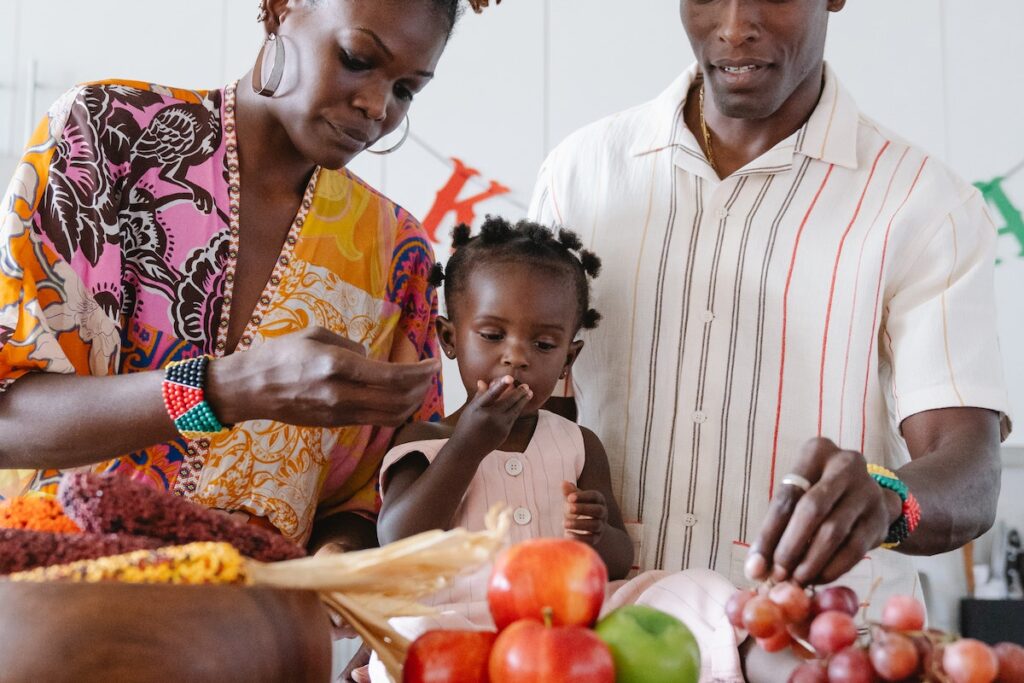As parents, we all want the best for our children, ensuring they grow healthy, strong, and ready to conquer the world. But today, we face a new challenge requiring immediate attention – childhood obesity.
In our beautiful country, we often celebrate wisdom passed down through generations with meaningful sayings, and one that particularly resonates with our discussion is, “A healthy child is a wealthy child.” These words hold as the health and well-being of our children lay the foundation for their future success and happiness.
Childhood obesity is a pressing issue that cannot be overlooked. As parents, we must be aware of its risks and take proactive steps to address this growing problem. The consequences of childhood obesity are far-reaching, affecting not only our children’s physical health but also their emotional state and overall quality of life.
So, let’s get on this journey together and unlock the secrets to defeating childhood obesity and cultivating a vibrant, energetic, and promising future for our little warriors.
Understanding Childhood Obesity
Let’s start by unraveling the mystery behind childhood obesity, my dear parents. Childhood obesity is when children carry excess body weight, specifically body fat, that can harm their health. Sadly, this issue has become alarmingly prevalent, not just in Kenya but across the globe.
Recent studies have shown that childhood obesity is on the rise. The allure of fast food, sugary drinks, and sedentary lifestyles has crept into our lives, posing a grave threat to our children’s well-being. We must confront this challenge head-on, armed with knowledge and determination, to safeguard the health of our little ones and guide them toward a brighter, healthier future.
Let’s look at the factors that contribute to childhood obesity.
- Genetic predisposition
- Surroundings have a significant impact on children’s weight.
- The availability of unhealthy food options, limited access to safe play areas, and the influence of advertising all contribute to the rising tide of childhood obesity.
- Children’s behavior, such as their eating habits and activity levels,
Health risks associated with childhood obesity
The consequences of childhood obesity are profound, and we must be aware of the risks that lie in its wake. Excess weight can burden our children’s bodies, leading to many health complications.
Childhood obesity increases the likelihood of developing serious conditions like heart disease, type 2 diabetes, and high blood pressure. Our little ones may also experience joint problems, sleep apnea, and even emotional difficulties such as low self-esteem and depression.
Healthy Eating Habits for Children
Importance of a balanced diet for children
A balanced diet ensures that our children receive essential nutrients, vitamins, and minerals for growth and development. It’s like building a sturdy house brick by brick, providing a strong foundation for their well-being. By offering a variety of foods from different food groups – grains, fruits, vegetables, protein, and dairy – we equip our little warriors with the energy, strength, and immunity they need to conquer any challenge that comes their way.
Nutritional requirements for different age groups

Breast milk or formula provides important nutrients for infants for optimal growth and development. As they transition to solid foods, introducing a variety of mashed fruits, vegetables, and pureed proteins helps expand their palate and nourish their tiny bodies.
As they become toddlers, encouraging self-feeding with finger foods allows them to explore textures and develop independence. For older children, it’s important to emphasize the importance of whole grains, lean proteins, and an abundance of fruits and vegetables
Tips for encouraging healthy eating habits
By planning meals, we can ensure our children receive a well-rounded diet. Fruits and vegetables are nature’s superheroes, packed with vitamins and fiber. Let’s make them a regular part of our children’s diet, offering them as snacks, incorporating them into meals, and showing their vibrant colors and flavors.
While indulgences are fine in moderation, limiting the intake of sugary drinks, snacks, and processed foods is essential. These can be like thieves at night, stealing away our children’s health. Instead, let’s focus on homemade treats and alternatives lower in sugar and higher in nutritional
Promoting Physical Activity in Children
Benefits of regular physical activity for children
Engaging in physical activity assists our children in developing sturdy bones and muscles, enhancing their heart health, and managing a balanced weight. It’s like oiling the wheels of a bicycle, allowing them to ride smoothly and effortlessly. Physical activity also boosts their immune system, increases their energy levels, and enhances their mental well-being, helping them stay focused and positive.
There are some recommended physical activity guidelines for different age groups; For infants and toddlers, floor-based play, tummy time, and interactive games encourage physical development.
As they grow into pre-schoolers, they should engage in at least 3 hours of active play throughout the day. Jumping, running, and dancing like nobody’s watching are their tickets to joy and strong bodies.
Children and adolescents of school age should strive for a minimum of sixty minutes of moderate to intense physical activity every day. This can include sports, bike riding, swimming, or even activities like helping with household chores.
Fun and engaging exercise ideas for children
Kenya’s breathtaking landscapes offer a natural playground for our children. Encourage them to explore the outdoors through hiking, cycling, playing soccer, or even traditional games like Kati. Let them soak up the sunshine and breathe in the fresh air.
When the raindrops fall, and outdoor adventures are on hold, we can turn to fun indoor activities that get our children moving. Dancing to lively Kenyan tunes or playing hide-and-seek can keep them active and entertained within the cozy confines of our homes.
Encourage them to walk or bike to school, take active breaks during study time, or involve them in household tasks like sweeping, washing dishes, or gardening. In this way, we infuse physical activity into their everyday lives, making it a natural and enjoyable part of their routine.
Screen Time and Sedentary Behavior
The significance of excessive screen time’s effect on childhood obesity cannot be emphasized enough. When children spend too much time in front of screens, whether watching TV, playing video games, or scrolling through social media, they become less physically active.
This sedentary behavior can lead to weight gain and an increased risk of childhood obesity. Screens can be like quicksand, slowly pulling our children away from the joys of movement and outdoor play.

- Setting screen time limits and rules
Setting clear guidelines regarding screen time duration and establishing rules that align with our family values is essential. Limiting screen time to no more than one to two hours per day can help prevent excessive sedentary behavior. Create designated screen-free zones and times, such as during meals or before bedtime, allowing for quality family interactions and better sleep.
- Encouraging alternative activities to reduce sedentary behavior
To reduce sedentary behavior and counterbalance screen time, let’s explore alternative activities that engage our children’s bodies and minds, dear Kenyan parents. Like the proverb says, “You cannot hide a cow on a milk jug,” we can’t hide from the truth that our children need active alternatives.
Encourage them to explore outdoor adventures like biking, hiking, playing tag, or flying a kite. Engage them in creative pursuits like painting, crafting, or playing musical instruments stimulating their imaginations. Let’s rediscover traditional Kenyan games like skipping rope.
Creating a Supportive Home Environment
Parents need to recognize their crucial role in preventing childhood obesity. By taking responsibility and actively participating in our children’s journey toward health, we shape a brighter future for them, free from the burden of obesity.
- Modeling healthy behaviors for children
Modeling healthy behaviors starts with our eating habits. Let’s show our children the importance of enjoying nutritious foods, savoring meals together, and prioritizing home-cooked meals over processed foods. As we embark on our fitness journeys, let’s invite them to join us in fun activities like jogging, dancing, or walking.
- Strategies for creating a supportive home environment
Now, let’s explore strategies for creating a supportive home environment that nurtures our children’s health and well-being.
- Fill your kitchens with fresh fruits, vegetables, whole grains, lean proteins, and dairy products. Let’s be mindful of the snacks and beverages we keep at home, ensuring they align with our goals of promoting health and well-being.
- Invite your children to participate in meal preparation, whether washing vegetables, mixing ingredients, or setting the table. This not only teaches them valuable life skills but also fosters a sense of ownership and pride in the food they eat.
- Engage in activities that bring the family together while promoting health and fitness. Whether going for walks in the neighborhood, playing sports in the backyard, or organizing weekend hikes, let’s create memorable moments celebrating the joy of being active together.
- Addressing Emotional and Psychological Factors
Parents need to explore the intricate relationship between emotions and overeating; it’s important to understand that food can sometimes be a coping mechanism to deal with stress, sadness, boredom, or other overwhelming emotions.
When our children experience intense emotions, they may turn to food for comfort or distraction. It’s like a temporary shelter, providing solace and relief. However, this emotional eating can lead to unhealthy habits and childhood obesity.
Promote open dialogue and establish a secure environment where children can freely share their feelings. Teach and encourage them to engage in activities that bring them joy and relaxation or that provide outlets for self-expression and stress relief;
- mindfulness techniques, deep breathing exercises,
- hobbies, creative outlets, or sports
How can you recognize signs of emotional eating? Signs of emotional eating may include:
- Eating when not hungry.
- Eating rapidly or in large quantities.
- Seeking out specific comfort foods.
- Using food to avoid or suppress emotions.
We must approach our children with compassion and understanding when we notice these signs. Let’s engage in open conversations, offering support and guidance and helping them identify and express their emotions in healthier ways.
Seeking Professional Help and Support
Knowing when to seek medical advice is very important. If you notice persistent weight gain, significant changes in our children’s eating habits, or concerns about their overall health, consulting with a medical professional is essential.
Consulting with healthcare professionals is a valuable step in addressing childhood obesity, dear parents. The expertise of healthcare professionals can guide us toward the right path for our children’s health whether it’s a pediatrician, nutritionist, or registered dietitian, healthcare. They can assess our children’s growth patterns, conduct necessary tests, and provide expert guidance tailored to their needs.
In our journey to address childhood obesity, finding community resources and support groups can provide immense comfort and encouragement. Sharing our stories, learning from one another, and receiving support from a community that understands our journey can give a sense of belonging and renewed motivation.
Conclusion
As we conclude our journey through this blog, let’s take a moment to recap the key points we have discussed. We started by understanding the importance of addressing childhood obesity and recognizing its impact on our children’s health and well-being. We explored the factors contributing to childhood obesity, from genetics to environmental and behavioral influences.
We delved into the significance of healthy eating habits, the benefits of regular physical activity, the impact of excessive screen time, and the role of emotions in overeating. We also emphasized the importance of seeking professional help and finding support in our communities.
Let’s be attentive to signs of emotional eating and teach our children effective coping mechanisms. And when needed, let’s not hesitate to seek medical advice and connect with community resources and support groups.
Remember, it’s within our hands to shape a healthier future for our little warriors. By acting against childhood obesity, we empower them to grow up strong, confident, and ready to conquer any challenge.











